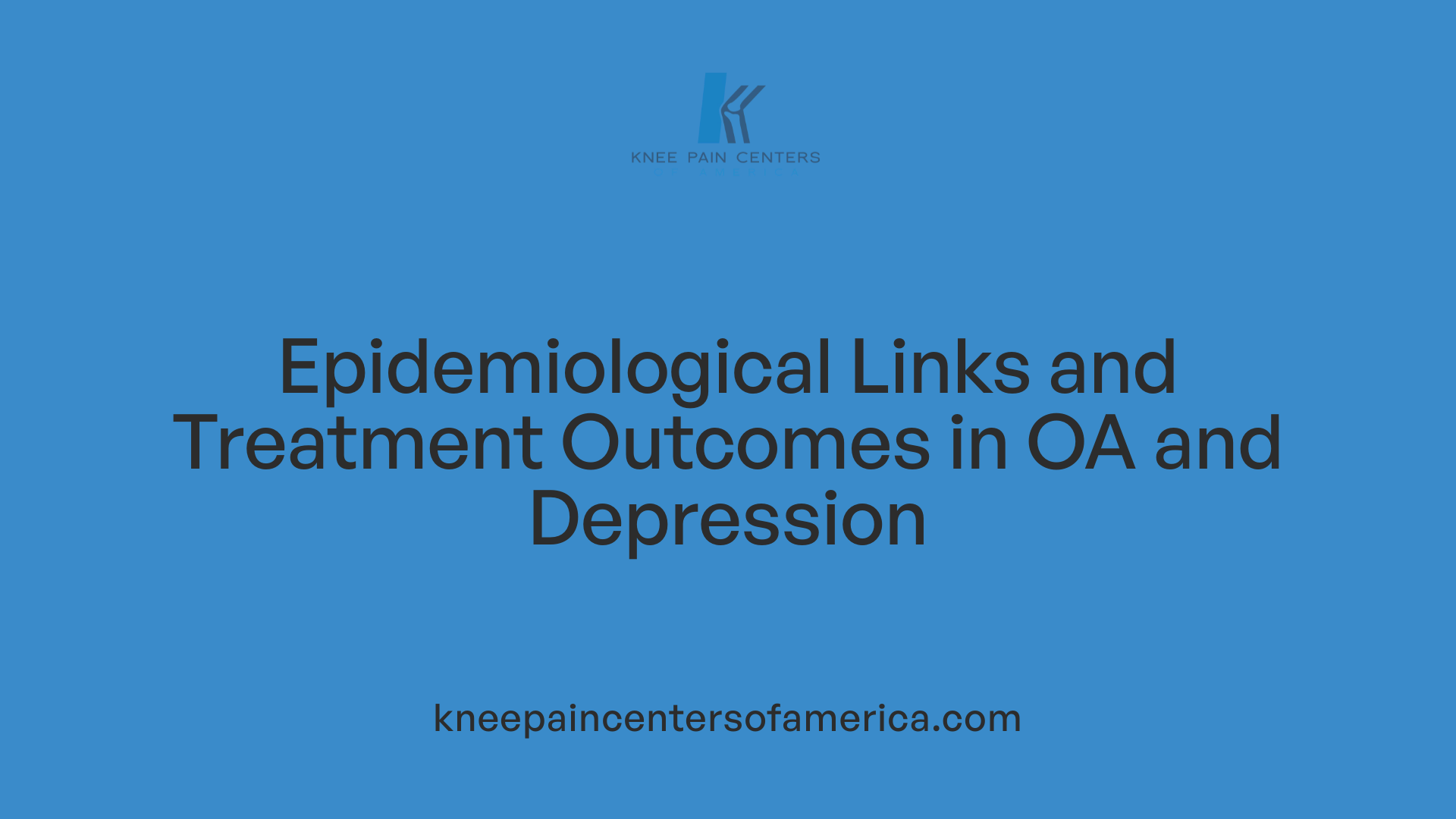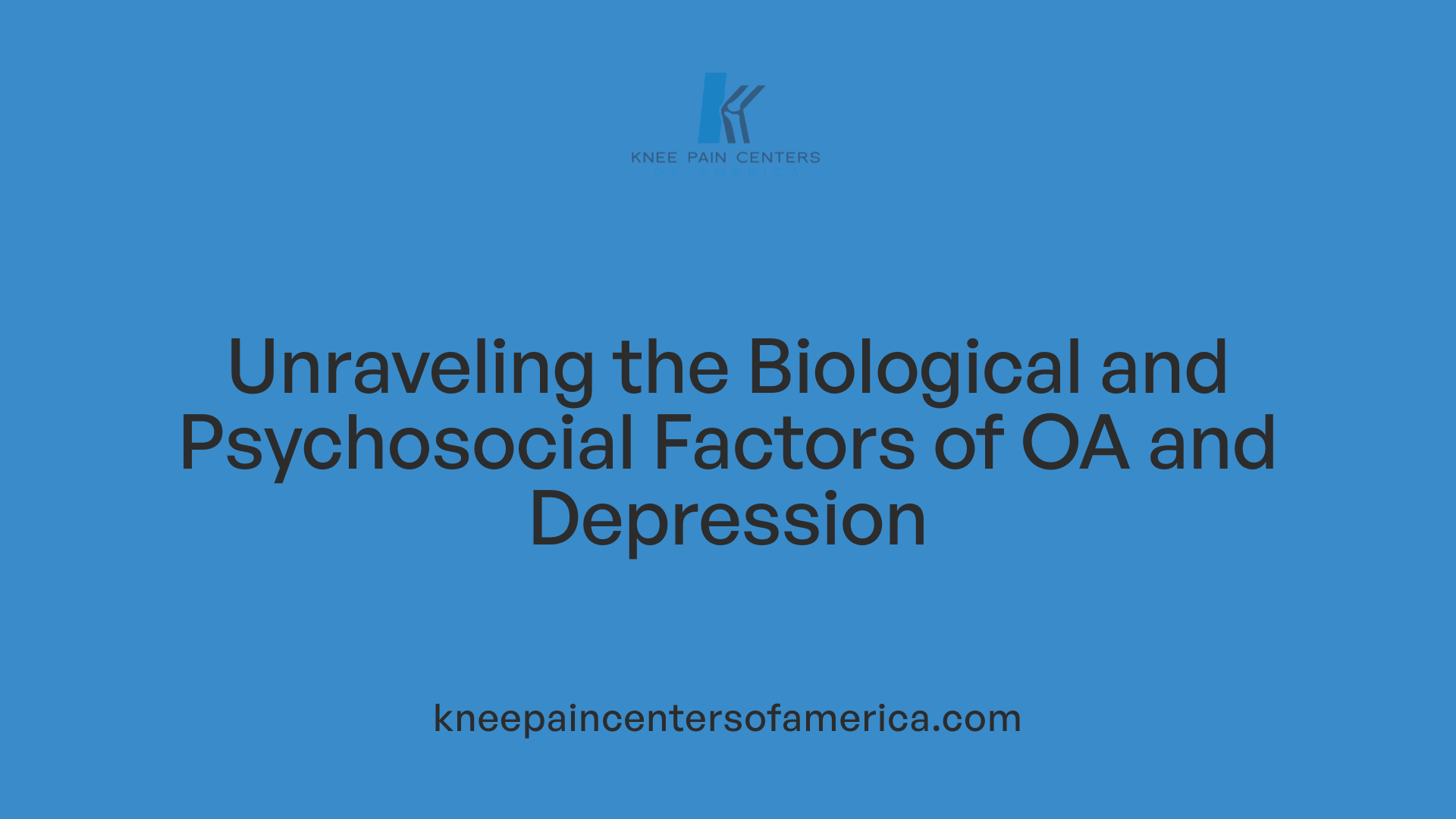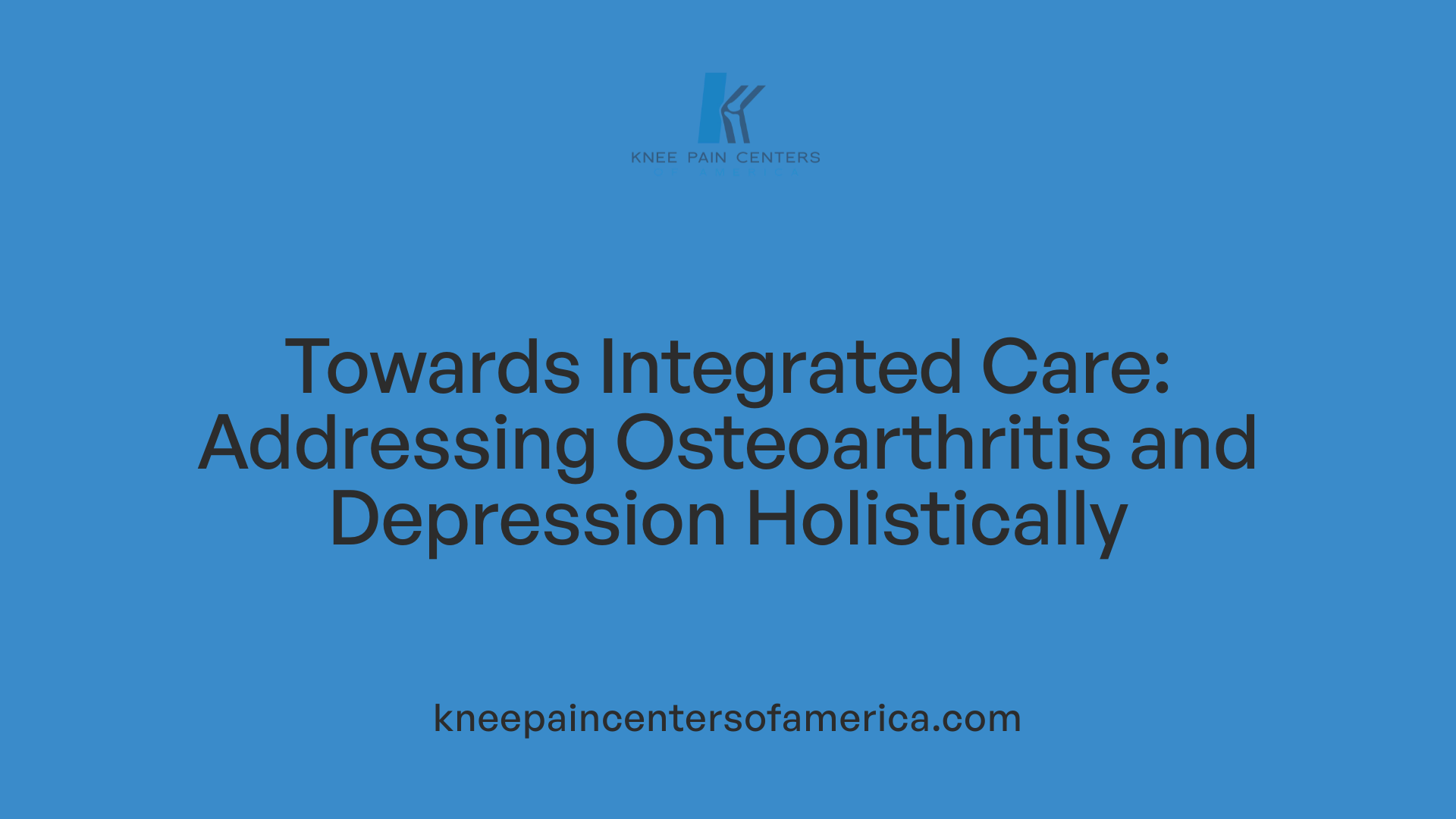Understanding the Bi-Directional Impact of OA and Depression
Osteoarthritis (OA), a common degenerative joint disease, and depression, a prevalent mental health disorder, are intricately linked in a complex, bidirectional relationship. With approximately 20-30% of OA patients experiencing depressive symptoms, this comorbidity significantly affects disease progression, treatment outcomes, and quality of life. Advances in research highlight the biological and psychosocial mechanisms underlying this connection, emphasizing the importance of integrated treatment strategies that address both physical and mental health aspects.
The Epidemiology and Significance of Co-Occurring Osteoarthritis and Depression

Prevalence of depression in OA patients
Depression is common among individuals with osteoarthritis (OA), affecting approximately 20% of this population. Specifically, the prevalence of depressive symptoms in OA patients is about 19.9%, with some studies reporting higher rates in certain subgroups like those with knee osteoarthritis, where the prevalence can be as high as 25.4%. These figures indicate a significant overlap, making depression a major comorbidity in OA.
Epidemiological studies linking OA and depression
Research from multicenter cross-sectional studies in countries like Australia and the United States has established a strong association between OA and depression. These studies reveal that people with OA have an increased odds ratio (OR of 1.41) for experiencing depressive symptoms compared to those without OA. Additional longitudinal studies also show that the incidence of depression can increase over time, especially in those with severe joint symptoms, pain, or functional limitations.
Impact of depression on treatment outcomes and quality of life
Depression in OA patients tends to worsen outcomes, leading to increased pain perception, reduced functional capacity, and lower health-related quality of life. It also raises healthcare utilization, resulting in more frequent doctor visits, medication use, and hospitalizations. Preoperative depression, in particular, has been linked to poorer postoperative results, including increased pain, slower recovery, and lower satisfaction after surgical interventions like joint replacements.
| Aspect |
Findings |
Implications |
| Prevalence |
~20% of OA patients experience depression |
High comorbid rate requires routine screening |
| Study results |
OR of 1.41 for depressive symptoms |
Highlights strong link between OA and depression |
| Impact on outcomes |
Worsened pain, function, QoL |
Need for integrated care approaches |
| Surgical outcomes |
Depression linked to poorer postoperative recovery |
Importance of mental health assessment pre-surgery |
Understanding the connection between osteoarthritis and depression is vital for improving treatment, reducing disability, and enhancing quality of life. Addressing both physical and mental health factors through comprehensive care strategies can lead to better overall health outcomes for these patients.
Biological and Psychosocial Mechanisms Underlying the Comorbidity

What is the current research on the connection between osteoarthritis and depression?
Research indicates a notable link between osteoarthritis (OA) and depression, with around 20% of OA patients experiencing depressive symptoms. These mental health challenges can worsen disease outcomes, increase healthcare costs, and diminish quality of life. The intertwining of OA and depression involves a complex web of biological and psychosocial factors.
A central biological mechanism is inflammation. Elevated levels of inflammatory markers such as cytokines—including interleukin-1, interleukin-6, and tumor necrosis factor-α—are common in OA and have been linked to depression. This systemic inflammation affects brain immune responses, which may contribute to depressive symptoms.
Structural brain changes are also implicated. Studies using neuroimaging techniques have identified reductions in hippocampal volume among individuals with OA and depression. Since the hippocampus plays a critical role in mood regulation and memory, its alteration can foster depressive states.
On the psychosocial side, factors such as ongoing pain, social isolation, perceived discrimination, and functional limitations significantly influence mental health. Chronic pain not only directly causes distress but can also lead to social withdrawal, reducing social contact and support, which further exacerbates depression.
The relationship is bidirectional: pain and inflammation can promote depression, and depression can heighten pain perception. For example, higher pain levels intensify the risk of depressive symptoms, while depression can impair coping, making pain feel more severe.
Current investigations emphasize the importance of comprehensive approaches. Treatments that reduce inflammation, encourage physical activity, and address social and psychological needs are promising. For instance, exercise therapy releases mood-enhancing chemicals and can decrease inflammation, thereby alleviating both OA symptoms and depression.
Ongoing research explores shared pathways, aiming to develop multimodal therapies—such as combining pharmacologic, behavioral, and physical interventions—that target both physical and mental health aspects simultaneously. Advances in screening tools and personalized treatment plans are essential to improve care for patients battling both osteoarthritis and depression.
The Role of Physical Activity and Lifestyle Modifications
How does physical activity affect depression in individuals with osteoarthritis?
Physical activity plays an important role in managing depression among people with osteoarthritis (OA). Research shows that increased physical activity is associated with fewer symptoms of depression. Specifically, exercise helps reduce the experience of pain, which is a significant contributor to depressive moods in OA patients.
A study involving 552 individuals from Australian hospitals found that physical activity not only decreases pain but also directly correlates with lower levels of depression. The relationship is particularly strong in those experiencing higher pain levels, where physical activity reduces pain more effectively, leading to a greater reduction in depression symptoms.
Furthermore, engaging in regular exercise improves physical function and overall quality of life. It boosts mood through the release of chemicals like endorphins, which act as natural painkillers and mood enhancers. Interestingly, while exercise improves mood and pain, it does not significantly impact sleep quality in OA patients, indicating that the emotional benefits are primarily linked to pain relief and physical function.
Despite barriers like discomfort and stiffness, even modest levels of activity can provide substantial mental health benefits. Promoting consistent physical activity should be a central component of managing depression in individuals with OA, helping improve both mental and physical health outcomes.
Mediation effect of pain reduction on depression alleviation
Reducing pain through physical activity is not just about improving physical symptoms; it also mediates improvements in mental health. Studies indicate that the pain reduction achieved via exercise partly explains the decrease in depression symptoms.
This mediation effect is especially pronounced in patients with severe pain. As pain diminishes, patients often experience a corresponding decrease in depressive feelings, which can lead to increased motivation to stay active.
This relationship underscores the importance of pain management in treating depression within OA patients. Interventions focused on pain relief, combined with physical activity, have the potential to significantly enhance mental health and overall well-being.
Benefits of mind-body exercises like yoga and tai chi
In addition to traditional physical activities, mind-body exercises such as yoga and tai chi are gaining attention as beneficial options for OA patients. These practices combine gentle physical movements with mental focus and relaxation techniques.
Emerging evidence suggests that yoga and tai chi can help reduce pain, improve flexibility, and enhance mood. These exercises also promote mindfulness, stress reduction, and better emotional regulation, which are crucial for managing depression.
Incorporating mind-body practices into the routine of OA patients offers a holistic approach to managing both physical and psychological symptoms. They are especially suitable for individuals who may find vigorous exercise challenging due to pain or mobility issues.
By integrating physical activity with stress-reduction techniques, patients can experience improved mental health and a better quality of life.
Psychological Impact, Screening, and Management Strategies in OA Patients
What are the psychological effects experienced by patients with osteoarthritis?
Patients with osteoarthritis (OA) frequently face significant psychological challenges, including depression and anxiety. Studies show that around 20% of individuals with OA experience depressive symptoms, with higher prevalence noted in specific types such as knee osteoarthritis. These mental health issues can lead to social withdrawal, decreased motivation for physical activity, and diminished overall quality of life.
Anxiety symptoms are also common, often manifesting as worry, restlessness, and physical symptoms like muscle tension, rapid heartbeat, or upset stomach. The chronic pain and functional limitations associated with OA not only cause emotional distress but also reinforce feelings of helplessness, which can further exacerbate depression and anxiety.
Social withdrawal, reduced social contact, and feelings of isolation are common psychosocial consequences of living with persistent pain and functional impairment. These feelings can strain relationships and decrease social support, which are crucial for emotional well-being.
What tools are used to screen for depression and anxiety in OA patients, and how effective are they?
Routine screening for depression and anxiety among OA patients typically involves validated questionnaires such as the Patient Health Questionnaire-9 (PHQ-9), Generalized Anxiety Disorder 7 (GAD-7), and other clinical scales. These tools help clinicians identify individuals at risk and facilitate early intervention.
While screening tools are valuable, evidence regarding their cost-effectiveness varies. Some studies suggest that targeted screening can improve detection rates, leading to better management, whereas others emphasize integrating screening into comprehensive care models to optimize resource use.
What interventions can help manage mental health issues in patients with osteoarthritis?
Effective management of psychological issues begins with early detection and personalized care. Psychotherapy options like cognitive-behavioral therapy (CBT) have shown to reduce depressive symptoms and improve coping mechanisms.
Support groups provide social contact and shared experiences, reducing feelings of isolation and offering emotional support.
Lifestyle modifications, such as engaging in regular physical activity, following a healthy diet, managing weight, and practicing mindfulness or relaxation techniques, can significantly improve mental health. Exercise, in particular, releases endorphins that act as natural mood lifters and pain reducers.
In addition to nonpharmacological approaches, pharmacotherapy—using antidepressants or anxiolytics—may be appropriate for some patients, especially when combined with psychological therapies.
Complementary strategies like yoga, meditation, art therapy, and music therapy are gaining interest for their stress-reducing benefits. Ensuring adequate social support and providing patient education about disease management also enhance resilience and emotional well-being.
What comprehensive strategies can be employed to address mental health in OA patients?
A holistic and individualized approach is essential. Early screening and diagnosis, combined with tailored interventions including counseling, lifestyle changes, physical activity, and medical treatments, can significantly alleviate mental health issues. Integrating mind-body therapies and fostering social connections are pivotal in reducing psychological distress.
Addressing emotional challenges through education, emotional disclosure, and partner-supported strategies can strengthen emotional resilience. Ensuring ongoing support and collaboration among healthcare providers—including rheumatologists, mental health specialists, and physiotherapists—can optimize mental health outcomes.
By prioritizing both physical and psychological health, clinicians can improve the overall quality of life for patients battling osteoarthritis, making a meaningful difference in their day-to-day experience.
Future Directions and the Importance of Integrated Care in OA and Depression

Why is understanding the link between osteoarthritis and depression important for treatment?
Understanding how osteoarthritis (OA) and depression are interconnected is vital for improving patient care. Research shows that depression affects roughly 20% of OA patients and can lead to poorer outcomes, increased healthcare costs, and a diminished quality of life. The relationship is complex and bidirectional: the pain and inflammation caused by OA can trigger depression, while depressive symptoms can intensify perceptions of pain and reduce motivation for self-care.
Recognizing this link encourages healthcare providers to adopt holistic, multidisciplinary approaches. Treating only the physical aspects of OA may leave mental health issues unaddressed, risking a cycle where pain and depression reinforce each other. By integrating psychological support—such as cognitive-behavioral therapy, mindfulness, and social interventions—alongside standard OA treatments, clinicians can help break this cycle, improving functional outcomes and emotional well-being.
Emerging research on shared pathways and treatments
Recent studies highlight common biological pathways—like inflammation and brain structural changes—that connect OA and depression. Elevated cytokines, such as interleukin-6 and tumor necrosis factor-alpha, are involved in both conditions, suggesting that anti-inflammatory treatments might benefit mental health as well as joint health. Neuroimaging research indicating hippocampal volume reduction in affected individuals further supports the biological ties.
Moreover, new treatments are being explored. For example, medications that target inflammatory pathways could potentially alleviate both pain and depressive symptoms. Simultaneously, research into mind-body practices such as tai chi and yoga shows promise in reducing inflammation, pain, and mood disturbance, offering nonpharmacological options.
Potential benefits of combined psychological and physical interventions
Integrating psychological therapies with physical treatment modalities has demonstrated encouraging results. Approaches such as exercise therapy not only improve joint function and reduce pain but also release mood-enhancing chemicals like endorphins. When combined with psychotherapy or counseling, these strategies can significantly lessen depressive symptoms.
Emerging studies suggest that concurrent management of pain, inflammation, and mental health can lead to better treatment adherence, reduced disability, and improved overall health status. Collaborative care models incorporating psychiatrists, rheumatologists, physical therapists, and psychologists exemplify this integrated approach.
The importance of interdisciplinary, patient-centered approaches
Advancing patient outcomes requires an interdisciplinary focus tailored to individual needs. Patient-centered approaches emphasize understanding each person's unique experience, including psychosocial factors like social support, discrimination, and functional limitations. This personalization ensures that interventions address not only physical symptoms but also emotional health.
Educational initiatives, support groups, lifestyle modifications, and stress management are integral. Early screening for depression using tools like PHQ-9, alongside routine OA assessments, facilitates timely intervention. Ultimately, a comprehensive strategy that combines medical, psychological, and social care can significantly improve quality of life for those living with OA and depression.
| Aspect |
Focus |
Benefits |
| Biological Pathways |
Inflammation, brain changes |
Identifies potential pharmacologic targets |
| Nonpharmacological Interventions |
Exercise, mind-body therapies |
Reduces pain and mood symptoms |
| Psychosocial Support |
Counseling, community programs |
Enhances social connectedness and resilience |
| Interdisciplinary Approach |
Medical, psychological, social |
Offers holistic, customized care |
Future research exploring these interconnected factors continues to grow, promising more effective, integrated treatment solutions for OA and comorbid depression.
Enhancing Patient Outcomes Through Holistic Approaches
The interconnectedness of osteoarthritis and depression necessitates a multidisciplinary, holistic approach to treatment and management. Recognizing the biological and psychosocial factors involved offers pathways for targeted interventions that can reduce pain, improve mental health, and enhance overall quality of life. Future research focusing on integrated therapies and personalized medicine holds promise for breaking the cycle of pain and depression, paving the way for better patient outcomes and more sustainable healthcare strategies.
References